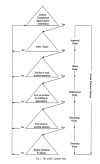Patient understanding of moles and skin cancer, and factors influencing presentation in primary care: a qualitative study
- PMID: 20807441
- PMCID: PMC2939514
- DOI: 10.1186/1471-2296-11-62
Patient understanding of moles and skin cancer, and factors influencing presentation in primary care: a qualitative study
Abstract
Background: Melanoma incidence in the UK has doubled over two decades, yet there is conflicting evidence about factors which prompt or delay patients seeking advice.
Aim: To explore patient understanding of pigmented skin lesions (moles) and skin cancer, and factors which influence seeking help in primary care.
Method: Semi-structured interviews with forty MoleMate Trial participants, analysed using the theoretical framework of the Safer-Andersen model of Total Patient Delay.
Results: Patient understanding and awareness was influenced by personal, family and friends' experiences of moles, skin cancer and other cancers, knowledge of risk factors, and the lay media. The route to consulting was complex and often iterative. For lesions that people could see, detecting and appraising change was influenced by comparisons with a normal mole on themselves, a family member, friend or image. Inferring illness came about with recognition of changes (particularly size) as serious, and associated 'internal' symptoms such as pain. For lesions that people could not see, family, friends and health professionals detected and appraised changes. Deciding to seek help was often prompted by another person or triggered by rapid or multiple changes in a mole. Three of four people subsequently diagnosed with melanoma did not seek help; instead, their GP opportunistically noticed the lesion.
Conclusions: Changing moles are often perceived as trivial and not signifying possible skin cancer. This study contributes to current national strategies to improve patient awareness and earlier diagnosis of cancer by highlighting factors that can trigger or act as barriers to seeking help.(ISRCTN79932379).
Figures
Similar articles
-
Delay in the diagnosis of cutaneous melanoma: an analysis of 233 patients.Melanoma Res. 2002 Aug;12(4):389-94. doi: 10.1097/00008390-200208000-00012. Melanoma Res. 2002. PMID: 12170189
-
A Reminder of Skin Cancer During the COVID-19 Pandemic.Acta Dermatovenerol Croat. 2021 Apr;291(1):58. Acta Dermatovenerol Croat. 2021. PMID: 34477068
-
Patient knowledge, awareness, and delay in seeking medical attention for malignant melanoma.J Clin Epidemiol. 1999 Nov;52(11):1111-6. doi: 10.1016/s0895-4356(99)00083-9. J Clin Epidemiol. 1999. PMID: 10527006
-
Melanoma risk factors and atypical moles.West J Med. 1994 Apr;160(4):343-50. West J Med. 1994. PMID: 8023484 Free PMC article. Review.
-
Cutaneous malignant melanoma: a primary care perspective.Am Fam Physician. 2012 Jan 15;85(2):161-8. Am Fam Physician. 2012. PMID: 22335216 Review.
Cited by
-
A systematic review and synthesis of qualitative and quantitative studies evaluating provider, patient, and health care system-related barriers to diagnostic skin cancer examinations.Arch Dermatol Res. 2022 May;314(4):329-340. doi: 10.1007/s00403-021-02224-z. Epub 2021 Apr 28. Arch Dermatol Res. 2022. PMID: 33913002
-
The trajectory to diagnosis with pulmonary arterial hypertension: a qualitative study.BMJ Open. 2012 Apr 18;2(2):e000806. doi: 10.1136/bmjopen-2011-000806. Print 2012. BMJ Open. 2012. PMID: 22514243 Free PMC article.
-
Which symptoms are linked to a delayed presentation among melanoma patients? A retrospective study.BMC Cancer. 2017 Jan 3;17(1):5. doi: 10.1186/s12885-016-2978-6. BMC Cancer. 2017. PMID: 28049453 Free PMC article. Clinical Trial.
-
Attributions of cancer 'alarm' symptoms in a community sample.PLoS One. 2014 Dec 2;9(12):e114028. doi: 10.1371/journal.pone.0114028. eCollection 2014. PLoS One. 2014. PMID: 25461959 Free PMC article.
-
Patient delay in cancer diagnosis: what do we really mean and can we be more specific?BMC Health Serv Res. 2014 Sep 12;14:387. doi: 10.1186/1472-6963-14-387. BMC Health Serv Res. 2014. PMID: 25217105 Free PMC article.
References
-
- NICE, Cancer service guidance. Improving Outcomes for People with Skin Tumours including Melanoma. 2006.
-
- Risberg T, Sorbye SW, Norum J, Wist EA. Diagnostic delay causes more psychological distress in female than in male cancer patients. Anticancer Res. 1996;16:995–999. - PubMed
Publication types
MeSH terms
Associated data
LinkOut - more resources
Full Text Sources
Medical


